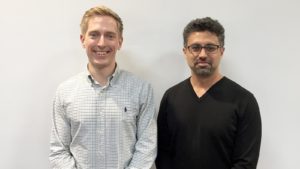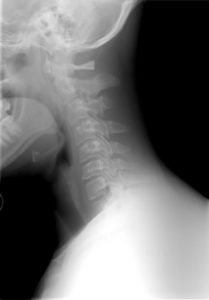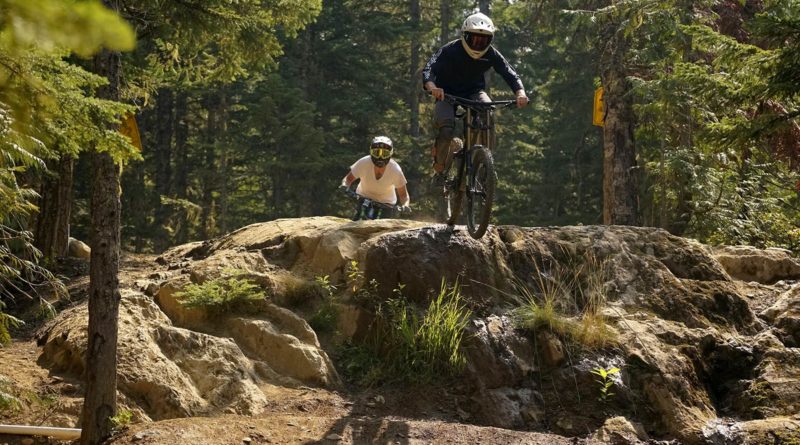Tim Lasswell – A-Line Orthopaedics
The A-Line trail is a mecca for mountain bikers.
Located in Whistler B.C., it’s the crown jewel of Whistler Resort’s bike park. The black diamond run, which spans a staggering 1,200 vertical feet, earned its reputation for its epic jumps. If you ride it right, you’ll spend a lot of time airborne.
And it’s one item Tim Lasswell, founder of A-Line Orthopaedics, checked off his bucket list this summer. He’s been mountain biking for over 10 years, by the way.
“It’s world famous as a fast-paced, high-energy trail, and that’s kind of what I wanted to mirror in our company. Fast-paced, hopefully world-famous one day,” he says.
A-Line is also a play on the word “align.” It’s a slightly more obvious connection to what Tim does off the trails as the creator of the DC2, a minimally invasive implant for faster and safer spinal surgeries.
The inspiration for A-Line and the DC2 came in stages, and it’s been an evolution, to say the least.
When Tim graduated from the University of Waterloo with his mechanical engineering degree, he figured he was done with school. But in the working world, he found he was becoming more project manager than engineer.
“I didn’t feel like I had cut my teeth on the technical nitty-gritty enough,” he says.
At the same time, a former professor was encouraging him to earn his Masters in Engineering. At first, Tim was hesitant. “In retrospect, I thank him for this. He was adamant about, you know, at least apply to NSERC. You might get the scholarship and at least you’ll have that option,” he says. “At the time I did it just to kind of get him off my back, but it ended up coming through.”
Tim took the opportunity figuring that, at the end of the two-year program, he’d have done enough grinding in the lab, with hands-on experience, that he could properly call himself an engineer when all was said and done.
So he returned to the University of Waterloo and began work on his thesis.
Picking the medical field as an area of study spoke to his family background. Tim’s father spent nearly 40 years as a medical device distributor in Canada, so he had some industry knowledge going into his research, he says.
“It was always on my mind. This is a super cool industry, and working with surgeons is great. Being in the operating room, viewing surgeries, thinking of new ways that you can improve the surgeries for the patients and the surgeon… it’s so exciting.”
It was through his thesis that he met his research partner and eventual co-founder, Dr. Parham Rasoulinejad. At first, they they wanted to focus on developing implants for use in spinal orthopaedics, but weren’t sure what, exactly, that would look like.

Dr. Rasoulinejad’s experience as a spine surgeon helped narrow the scope for their first product. “He actually put us onto the issue of upper cervical spine fractures and how they’re very tricky to treat with current spine implants.”
(A short explainer: your upper cervical spine is the area of your neck that meets your skull. Its main jobs are to protect your spinal cord, support the weight of your head and allow for the majority of your neck’s rotation.)
And in terms of implants, there aren’t too many options, though it’s expanding fast today. “Spine is still very much the wild west of orthopaedic surgery with lots of opportunity to develop innovative products that will improve patient outcomes,” says Tim.
Hip surgeries are already well-studied, and often successful. “Now the outcomes of that are really good, in the high 90 per cent. You can go get a total hip tomorrow and that’ll last you 20 years,” he says.
For spine, the results aren’t as good. “If you get a spine surgery, it’s pretty much a 50-50 chance if you’re going get that outcome you’re looking for.”
But that means there’s lots of room to improve, he says. “There’s a huge opportunity for product differentiation to get in. There’s different surgical techniques, different implants.”

He and Dr. Rasoulinejad decided to prototype a new kind of implant that would stabilize upper neck fractures in a way that’s much safer than the implants used today. But again, his focus wasn’t on starting a company, but rather to do the research, get some exposure to the area, and publish some papers to forward the literature.
That changed when the results from the implant’s lab testing and cadaver study started rolling in.
“Our results and experiments ended up looking very good, and actually it outperformed the existing implants on the market,” he says. “That’s when we decided there’s something here that keeps us going, and we should try to get some funding to commercialize and mass produce it.”
The next stop on the path to commercialization? “We’re going down the regulatory road,” he says. “We know the performance is there but now we have to make sure the efficacy is there was well. We’ve got to look at things like fatigue testing, making sure that the implant doesn’t fall apart over time … then we have to look at other things too, like biocompatibility, sterilization and things like that.”
The award he received at the Velocity Fund Finals in spring 2018 is helping him get there. He walked away with a $25,000 prize for his pitch and an additional $10,000 as the top hardware company in the competition.
It’s no easy process, but the work is worth it for better patient outcomes and surgeon success. “Just to know that the things I’m working on today are going to hugely impact and positively impact people in the future is very exciting,” he says.
“There are days where I just think to myself – good day or bad day – I’ve really got one of the coolest jobs in the world right now. There’s really nothing else I’d prefer to be doing.”
Except maybe riding the A-Line.
Learn more at:
www.alineorthopaedics.com

